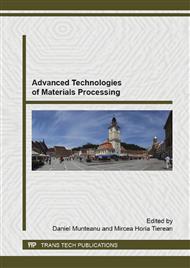p.271
p.282
p.288
p.293
p.303
p.315
p.322
p.332
p.338
Studies on the Possibility of Recycling Waste Bronze
Abstract:
This paper presents the results of experimental research on the possibility of using bronze chips recovered from the cutting process of the molded sliding bearings to obtain new sintered sliding bearings. This paper presents the results of experimental research on the possibility of using bronze chips recovered from the cutting process of cast sliding bearings in developing new sintered bearings). The cooper-tin alloys have many applications in the industry and they are usually used as antifriction materials to sliding bearings construction. Chips recovered from cooper-tin resulted from the cutting process were used to obtain metal powders in planetary mills. Recovered powders were then compacted to a unilateral mold and then were applied a sintering cycle in argon. To the obtained samples we applied wear tests in conditions of dry friction to prove the possibility of use as anti-friction material for sliding bearings in similar conditions to those obtained from industrial powders.
Info:
Periodical:
Pages:
303-311
Citation:
Online since:
October 2015
Authors:
Keywords:
Price:
Сopyright:
© 2015 Trans Tech Publications Ltd. All Rights Reserved
Share:
Citation:


